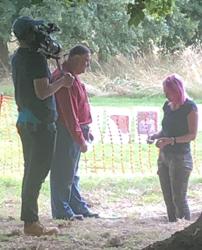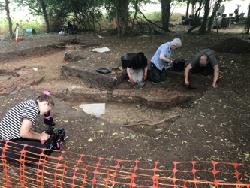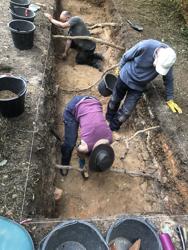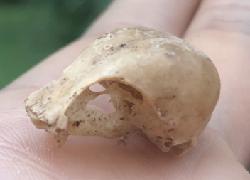19 Jul 2023
2023 Summer Dig - Day 10


Another great day's digging in Forty Hall today, on day 10 of our 14-day hunt for the inner gatehouse of the Tudor palace of Elsyng, in the Hall's lime tree avenue.
It was also a slightly unusual day, as we were joined by Professor Alice Roberts and a crew from Rare TV, who are currently filming series eleven of Digging For Britain.
We were very pleased to introduce Alice to the site, and even more pleased to have some splendid Tudor archaeology for the programme.
Filming began this morning in the lime tree avenue and moved initially to Trench 3, where we have been looking for the end of the moat that we found last year, where evidence suggested it should have met the range of buildings that define the north side of the palace's outer courtyard.
The archaeology in this trench is still slightly ambiguous, since although we did find evidence of the end of the moat cut, which included its characteristic finds-rich rubble fill, there was no sign of the expected adjacent building range, which leaves the question of how the moat and outer courtyard meet, currently unresolved.
Nevertheless, having finished excavation in this trench, once filming moved on we were able to finish fully recording it and it was backfilled in the afternoon.

Meanwhile later in the morning we laid out a further southern extension of Trench 4, to expose more of what we now suspect is a perimeter boundary wall, reinforced by octagonal columns, separating the palace's two courtyards, and we are now all but certain that the octagonal tower attached to its north end belongs to a major palace building - the inner gatehouse is a strong contender.
This extension has now fully revealed the outline of the slightly larger of the two octagonal column bases built into the wall, and shows that the narrow wall continues to run south, now within a metre of the sharp break of slope that defines the man-made platform that these structures are built on.
Further extension of the trench was planned today but was limited by the disturbance of a wasps' nest close to the trench edge. We hope that the wasps will calm down and disperse enough overnight to allow the safe extension of the trench tomorrow, to find out what happens when the wall meets the break of slope.

Excavation also continued all day in Trench 7, which we laid out a few days ago as close to the north side of the octagonal turret as we could get - the north edge of the turret being inaccessible due to dense tree coverage.
Although we have found the beginnings of a wall at the east end of this trench it is not on the expected alignment of the turret wall, and today we did not reveal much more of it, since we are currently removing what has turned out to be a very deep and extremely mortar-rich demolition context at the west end of the trench.
This is the area that yesterday produced a large collection of dressed stone fragments and today continued to yield several more fine examples of window stonework complete with tool marks, and also several shaped and moulded bricks, some possibly from decorative chimneys.

But perhaps the most remarkable find of the day, from the very same context, was the incredibly delicate skull of a small bird.
We've tentatively identified it as the skull of a passerine bird, perhaps of the thrush family.
Tomorrow we should hopefully see more of the wall in Trench 7 and get a clearer picture of the building from which all the mortar, rubble and dressed stone fragments derived.
It was a pleasure to introduce Alice and company to the site and to share the fun and excitement of rediscovering this lost chapter of Tudor history.
We look forward to seeing the 11th series of Digging For Britain when it airs on BBC2 early next year!